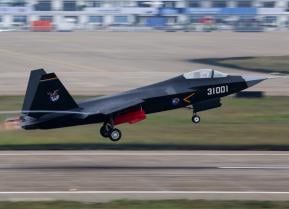Marine Corps Rocket Batteries Could Kill Naval Vessels (Thanks to the F-35)
The test, which took place in Yuma, Arizona sometime prior to mid-October 2018, involved a Marine F-35B detecting a metal container on the ground and passing the GPS coordinates via radio datalink to one of the Corps’s wheeled High-Mobility Artillery Rocket System launcher.
HIMARS packing anti-ship missiles could give the Corps a serious, and seriously survivable, coastal-defense capability. Launchers could “shoot and scoot” to escape counter-fire. “After firing each volley, the missile battery would move to a new hide site and await orders to fire again,” the think-tank RAND explained in a 2017 report.
The U.S. Marine Corps recently proved that an F-35 stealth fighter can pass targeting data to a ground-based rocket launcher.
(This first appeared last month.)
The test, which took place in Yuma, Arizona sometime prior to mid-October 2018, involved a Marine F-35B detecting a metal container on the ground and passing the GPS coordinates via radio datalink to one of the Corps’s wheeled High-Mobility Artillery Rocket System launcher.
The HIMARS launcher fired a rocket at the coordinates. “We were able to target a particular conex box,” Lt. Gen. Steven Rudder, the Marines’ deputy commandant for aviation, told an audience at a think tank in Washington, D.C. on Oct. 12, 2018.
The test represents the latest expansion of the Marines’ rocket capabilities, which could play a significant role in any future high-intensity conflict. The Corps doubled its spending on HIMARS from $68 million in 2017 to $134 million in 2018.
The extra cash bought additional resupply vehicles for the Marines’ nine HIMARS batteries, each of which possesses six, 12-ton launchers. The Corps is also experimenting with new operating concepts for its rocket force — for example, launching rockets from the flight deck of the assault ship USS Anchorage in October 2017 and, in March 2018, quickly transporting a launcher aboard a C-130 transport plane, firing four rockets, driving back into the plane and flying away.
The Marines are also considering buying an anti-ship missile for its HIMARS launchers. But existing rockets also work against ships. During the Rim of the Pacific war game in and around Hawaii in July 2018, a U.S. Army HIMARS battery struck the decommissioned U.S. Navy amphibious ship Racine with five rockets. An aerial drone provided the coordinates for the 50-plus-mile strike, pictured at top.
The HIMARS’s primary rocket is the Guided Multiple Launch Rocket System, with a 200-pound warhead and a maximum range of 50 miles. A single HIMARS launchers can carry, and launch, six of the GPS-guided GMLRS at a time. The larger Army Tactical Missile System packs bomblets or a 500-pound unitary warhead and can fly as far as 186 miles. A HIMARS can fit one ATACMS at a time.
The Army is developing a new, mid-size rocket with a 310-mile range — two of which can fit in a HIMARS. The Army and Marines are also exploring the possibility of adapting Raytheon’s 100-mile-range Naval Strike Missile to be compatible with HIMARS.
Recommended: What Will the Sixth-Generation Jet Fighter Look Like?
Recommended: Imagine a U.S. Air Force That Never Built the B-52 Bomber
Recommended: Russia's Next Big Military Sale - To Mexico?
Recommended: Would China Really Invade Taiwan?
HIMARS packing anti-ship missiles could give the Corps a serious, and seriously survivable, coastal-defense capability. Launchers could “shoot and scoot” to escape counter-fire. “After firing each volley, the missile battery would move to a new hide site and await orders to fire again,” the think-tank RAND explained in a 2017 report.
Long-range rockets require long-range targeting. When the target is a ship at sea, human forward observers aren’t an option. That the Marines are experimenting with F-35s as aerial observers for rocket strikes underscores how serious the Corps is about hitting targets far away. Including ships.
This first appeared in WarIsBoring here.


